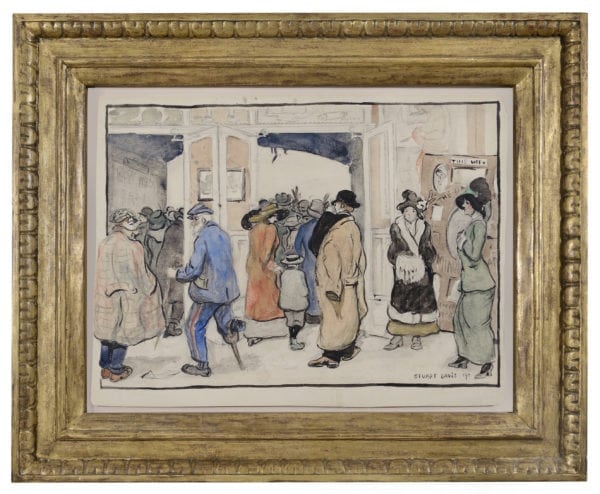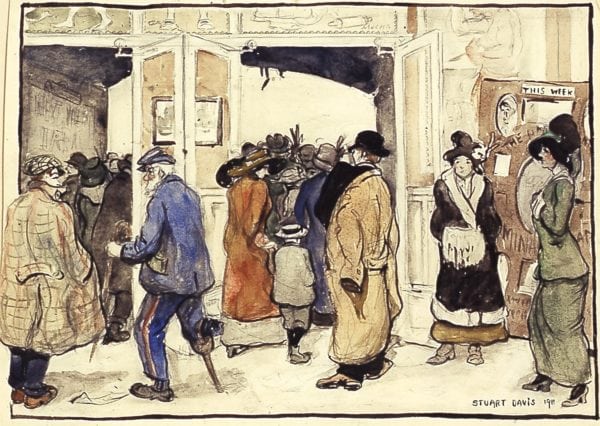Theatre Crowd, 1911
Stuart DavisWatercolor on paper
14 × 18 1⁄2 inches
Signed and dated (at lower right): Stuart Davis 1911
Provenance
The artist
Estate of the artist; New Jersey
Private collection, New York
Stuart Davis was an artist of incredible range. His oeuvre is composed of paintings, drawings, published illustrations, watercolors and gouaches, and textile and tabletop designs. His first artistic attempts were drawings, and he illustrated the stories he told to his younger brother, Wyatt. In this respect he followed in his father’s footsteps; Edward Wyatt Davis was a cartoonist as well as an art editor.26 During the 1890s, while working at the Philadelphia Press, Edward Davis befriended Robert Henri (1865–1929), John Sloan (1871–1951), William Glackens (1870–1938), George Luks (1867–1933), and Everett Shinn (1876–1953). At that time they all worked as illustrators for various newspapers in Philadelphia. Growing up and studying in this milieu, it is not surprising that Stuart Davis’s early work is devoted to illustrations and drawings. Davis arrived in New York in 1909 to study with Henri. Remembering those early days, Davis stated, “We were encouraged [by Henri] to make sketches of everyday life in the streets, the theater . . . and everywhere else . . . Enthusiasm for running around and drawing things in the raw ran high.” Selecting motifs from his own environment, “that expressed the . . . vitality Henri saw in contemporary life,” would remain one of the founding principles of Davis’s art. Theater Crowd takes place in a theater foyer. The doors to the auditorium are wide open and in typical New York fashion, most of the spectators are crowding into the inner hall, while a number of city ‘types’ are placed in the interstitial space.
In this shallow vestibule, a well-dressed central figure is shrugging off his coat; one sleeve already hangs limply. To his left stands an older gentleman with a peg leg and a cane, who is dressed in a vaguely military style uniform. Davis and the other members of the Ashcan School relished including the diversity of New Yorkers (and all their eccentricities) in their city scenes. It is worthwhile to mention that a broad swath of the population attended the theater and other productions at this time. The older gentleman approaches another character all the way on the left, standing with a swagger, collar up, and back to the viewer. This figure breaks through the picture frame creating a visual bridge into the scene for the viewer, as does the woman with the muff, facing us and waiting for a companion. Within the foyer is a large sign publicizing the current week’s schedule, while inside the doors on the left is a poster announcing the next week’s upcoming performances—a testament to the hectic pace of one New York venue. Above and around the doors, decorative murals are sketched. Closer inspection reveals a signature in the mural right above the right-hand door—‘MUCHA’. Alphonse Mucha (1860–1939), the renowned Art Nouveau artist, had, indeed, been in New York around this time. Mucha decorated the German Theater on Irving Street, in 1908, situating Davis’s watercolor in the vibrant New York theater world. Drawn with a bold contour line, Davis’s style is reminiscent of graphic work by artists ranging from Francisco de Goya (1746–1828), to Honoré Daumier (1808–1879), and Henri Toulouse- Lautrec (1864–1901). Henri held these caricaturists in high esteem and he presented their work to his students. Davis, himself, owned a set of Toulouse- Lautrec reproductions. His work shares some of the stylistic hallmarks of these great illustrators. In Theater Crowd, Davis uses large areas of flat color to strengthen areas first defined with a pencil, such as the brown and orange coats worn by the women, the green of another’s dress, and the deep blue of the military costume. Additionally, differences in tone create depth and space, wherein the thickly drawn figures stand in high relief against the much lighter background. In concise works, such as this, specificity imparts vitality. By creatively alternating the position of each figure’s feet throughout the foyer, for example, Davis further individualizes each character, imparting a sense of observed reality. Davis’s style would evolve significantly over the coming decades, but his commitment to the variety of urban life was unwavering.
Exhibited
- “Stuart Davis: The Amazing Continuity,” organized by the American Federation of Arts, traveling to: Terra Museum of American Art, Chicago, 12/92-2/93.
- Middlebury College Museum of Art, Vermont, 3-5/93.
- Marion Koogler McNay Art Museum, San Antonio, TX, 5-7/93.
- Center for the Fine Arts, Miami, FL, 8-9/93; Joslyn Art Museum, Omaha, NE, 2-4/94.
- The Phillips Collection, Washington, DC, 5-7/94.
Literature
- Stuart Davis: Early Watercolors and Drawings, 1910–1918, Mary Ryan Gallery, New York, July 27–August 15, 1987 (as Lobby Interior).
- Karen Wilkin and Lewis Kachur, The Drawings of Stuart Davis: The Amazing Continuity, New York, Abrams with the American Federation of Arts, 1992, p. 49, no. 6, ill. (color).
- Stuart Davis: A Catalogue Raisonné, Volume 2, eds. Ani Boyajian and Mark Rutkoski, New Haven, Yale University Press, 2007, p. 450, no. 941, ill. (color).


